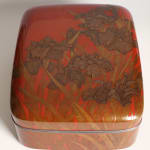Funamoto Migiwa
Accessory Box with Irises, circa 1935
Kanshitsu dry lacquer, maki-e gold and silver lacquer
Size 6¾ x 16¾ x 13¼ in. (17 x 42.7 x 33.8 cm)
T-4813
Further images
-
(View a larger image of thumbnail 1
)

-
(View a larger image of thumbnail 2
)

-
(View a larger image of thumbnail 3
)

-
(View a larger image of thumbnail 4
)

-
(View a larger image of thumbnail 5
)

-
(View a larger image of thumbnail 6
)

-
(View a larger image of thumbnail 7
)

-
(View a larger image of thumbnail 8
)

-
(View a larger image of thumbnail 9
)

-
(View a larger image of thumbnail 10
)

-
(View a larger image of thumbnail 11
)

-
(View a larger image of thumbnail 12
)

-
(View a larger image of thumbnail 13
)

-
(View a larger image of thumbnail 14
)

-
(View a larger image of thumbnail 15
)

-
(View a larger image of thumbnail 16
)

-
(View a larger image of thumbnail 17
)

A tebako (accessory box) of standard historical form with rounded corners and slightly bowed sides, the kabusebuta (overhanging lid) with a narrow chiri-i (“dust-ledge”) and slightly domed top, the wood...
A tebako (accessory box) of standard historical form with rounded corners and slightly bowed sides, the kabusebuta (overhanging lid) with a narrow chiri-i (“dust-ledge”) and slightly domed top, the wood substrate entirely covered outside in polished red lacquer decorated on the top and sides in gold and aokin hiramaki-e and takamaki-e with flowering irises, the interior with a gold-lacquer ground decorated in black, red, and gold maki-e with stylized nadeshiko (pinks, Dianthus superbus), metal rims
Little information is available regarding this lacquerer beyond the information that he lived in Tokyo and was already active in 1929. This splendid box shows him to have been an outstanding master of the more naturalistic maki-e (“sprinkled picture”) style developed during the 1920s by artists such as Akatsuka Jitoku (1871–1936), with skillful relief modeling and surface textures contributing to a decidedly painterly appearance. In complete contrast to the exterior of the box, the inner surfaces are finished in a striking emulation of an Indian woodblock-printed cotton (chintz) pattern that simultaneously evokes the luxurious silk-brocade linings seen inside some medieval Japanese boxes.
Little information is available regarding this lacquerer beyond the information that he lived in Tokyo and was already active in 1929. This splendid box shows him to have been an outstanding master of the more naturalistic maki-e (“sprinkled picture”) style developed during the 1920s by artists such as Akatsuka Jitoku (1871–1936), with skillful relief modeling and surface textures contributing to a decidedly painterly appearance. In complete contrast to the exterior of the box, the inner surfaces are finished in a striking emulation of an Indian woodblock-printed cotton (chintz) pattern that simultaneously evokes the luxurious silk-brocade linings seen inside some medieval Japanese boxes.
















